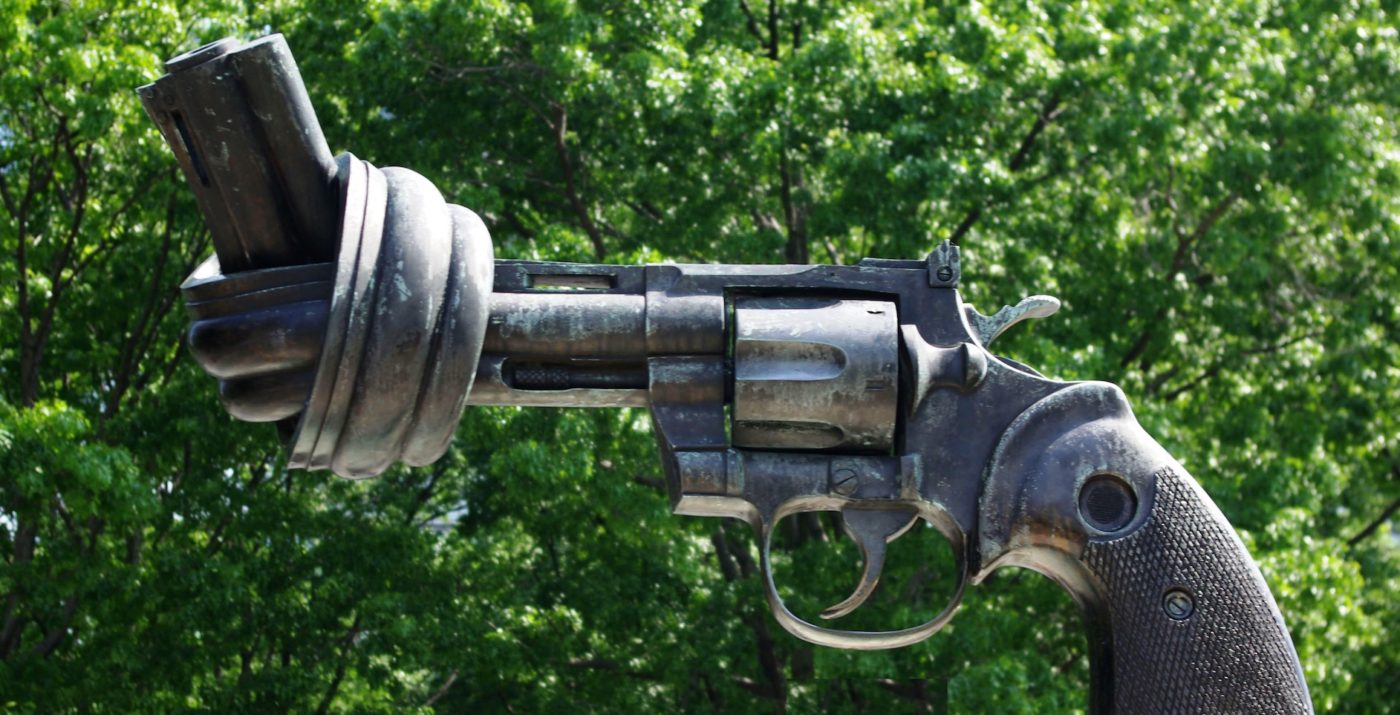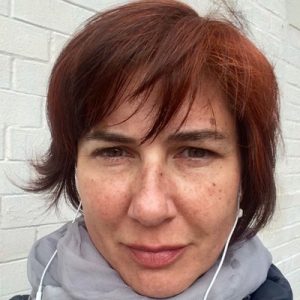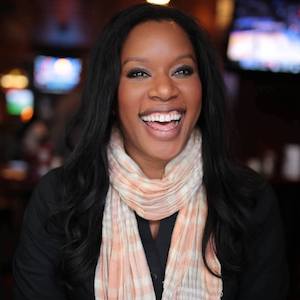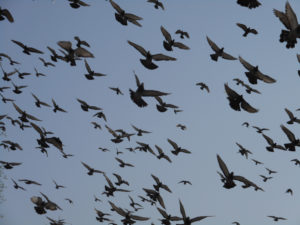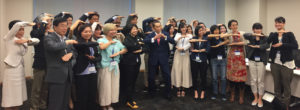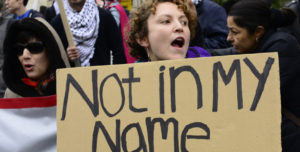When Amber Goodwin realised there were no people of colour in the leadership of the movement to prevent gun violence in the United States, she founded a movement for black people—led by black people.
“Black people are disproportionately affected by gun violence. I felt I needed to change this, and to change the conversation about gun violence prevention.”
–Amber Goodwin
Thirty-three thousand Americans die by gun violence each year. But while mass shootings like recent incidents in Las Vegas and Texas garner enormous media coverage, 98 percent of deaths caused by gun violence receive little attention. The vast majority of incidents involving gun violence occur, Goodwin explained to MobLab, “In neighbourhoods where people who look like me live.”
Goodwin founded Community Justice Reform Coalition (CJRC) just one year ago. CJRC promotes and invests in evidence-based policies and programs to prevent gun violence and uplift criminal justice reforms in urban communities of colour.
Amber Goodwin grew up in Midland, Texas, where her family was one of a tiny minority of African-Americans. She moved to Washington, D.C. in 2002; and over the ensuing 15 years built a career as an organiser and campaigner. She cites her 2007-8 experience as a field organiser in Houston for the Obama campaign as a formative one.
Goodwin accepts that she has chosen a challenging career of low financial remuneration and many setbacks. She credits her athletic background for her determination and self discipline. “I swam competitively starting from the age of three, until I was 23,” she said. “I think about this a lot when I meet other athletes: you have that long-term determination. You know how tough it is to lose, but you also know that you have to pick yourself up again. That is why I know that the U.S. presidential election of November 8, 2016 was not the end of anything.”
How do you define goals and successes when you are organising a campaign?
I started CJRC by mapping out who was doing the work, who had the resources, and who was affected by gun violence. Then we could see the gaps–where our work could have the most impact.
Part of our goal in fighting gun violence is to centre on people of colour who have been working on this issue. We also needed to widen the base of support beyond people directly impacted by gun violence–while staying focused on them. We needed to look at people who had a vested interest, or who were mission aligned.
In other words, look for allies who might not be affected directly by gun violence, but who care about the issue for pragmatic or idealistic reasons.
“The challenge is to get people to care about what is happening in Chicago and Oakland on a daily basis, versus the mass shootings that receive so much media attention. That’s the conversation we want to change.”
What is the biggest challenge you face right now?
Our biggest challenge is a lack of funding for the implementation of creative strategies that have already been proven effective. The idea is to intervene before somebody picks up a gun. But government has cut the funding for these programs.
Our approach is to figure out what the causes of gun violence are and attack them like a disease, rather than criminalising it and othering people. We want to invest in people as humans. We know that most active shooters are people who have had violence committed against them by police or other people in their communities.
What is the one tool you cannot work without? Why?
I can’t live without a calculator! As an entrepreneur working on social impact I have to account for every dollar that goes in and out; I have to constantly hire new people and give resources to folks at the grassroots level. At the end of each day I calculate how much money we have in the bank and work out how to disburse it, and during the day I frequently stop to crunch numbers. Besides my laptop and my phone, I have a hand-held calculator that I consult constantly.
Is there a new campaigning tool or tactic you’re testing right now? What do you think of it so far?
We are testing ads on Facebook to see if the people who are impacted by gun violence respond to our outreach via social media, to our solution-based message.
Not everyone can travel to volunteer in areas that are heavily affected by gun violence. But they can help us remotely via social media. We can tell them how to make calls to elected officials, for example; and we can design strategies for change that tackle the issues in a non-conventional way. My work as a community organiser taught me that there is no one way to do this work–it must be multifaceted.
Is there a recent campaign that you can point to as an example of how you successfully used specific tactics to achieve an identified target or goal?
The Obama electoral campaign of 2008 was revolutionary in its use of data and analytics, which informed the campaign. It was also groundbreaking in the way it channeled community organisers, which is the work I was involved in. We identified a local leader who put together a team that focused on the unique issues affecting their community. Each local organiser had teams that worked with–not under–them. Their job was to collect data from phone banks, recruit other people and help with social media.
From my work with the Obama campaign I also learned to focus on people who will vote for your candidate, or who you can engage with, while understanding that some folks are not persuadable.
What are three things an activist should be, have or know?
“I try to be very cognisant that I’m just one person who has been in this fight against gun violence for just four years, and there are others who have been doing this for decades.”
Humility is a big one. One of the hardest parts of organising is staying humble at the end of the day. What I see all the time is a desire to put people on a pedestal. With 92 people dying in gun violence every day, I cannot be caught up in having received an award or a grant. The grant will go to those who need it.
Flexibility. Being able to change course is very important. This is something that has been very hard for me over the past year. I didn’t have a lot of thought partners except for Pastor Mike McBride and the other Advisory Board members, but on a day to day basis it was my responsibility to raise money, make decisions, and click ‘send’ on an email for 10,000 people.
Determination. This is something I also learned along the way. At the end of the day I am responsible for this organisation–for the staff, for the people who are depending on us to get them resources. I don’t want to misrepresent people impacted by gun violence everyday. Which means I will sometimes not agree with those in the anti- gun violence prevention movement if they are pushing an initiative that we believe may harm communities of colour.
I need to look to them to lead what this organisation does and doesn’t do.
What book did you read most recently or are you reading right now?
I am reading Superficial, by Andy Cohen. He’s the executive producer of Real Housewives on Broadway. I was reading it on the plane over here; it’s literally about reality TV.
Is there an ongoing campaign that you find particularly interesting or inspiring?
There are a lot of campaigns working with the LGBTQ community that I find inspiring. I have friends who are working to get more rights for trans women of colour. There’s one called Third Wave Fundthat’s been around for 30 years, but I had no idea it existed. They were not getting resources to run campaigns. My friend Rye Young just got some funds and is making sure they are really inclusive. They are trying to get resources directly to people who need it, like trans women of colour who experience domestic violence and gun violence; in the United States if you’re not cis gender from a middle-income family you don’t get the same support.
Do you have a favourite podcast?
I listen to a lot of news podcasts, like The Daily from the New York Times. I like Two Dope Queens and The Read, which is a great one hosted by two comediennes. I listen to a lot of true crime, like Case Files. And I listen to The Moth.
Who do you follow on social media for campaign news and insights?
I follow Beyonce–just in case there’s any breaking news [laughs]! I also follow thought leader type people, like Roxane Gay and some of the BuzzFeed people. I love Ana Navarro, the CNN political commentator. I follow some of my friends who are fellow organisers, people who are leading on immigration and political campaigns.
What is it about your work that inspires or excites you?
“I am inspired by the people who do this work every day because it is the right thing to do. These are people who do this work for no money or recognition; people who have been affected by gun violence.”
I have a friend in Oakland who went through the whole gun violence interruption program, which has since been defunded. He is an amazing person who is doing so much good, leading so many different efforts outside of gun violence. For example, he leads a program called Books and Breakfast. It offers a safe space where people can learn and eat, or just sit around and have a conversation with other folks. This builds a sense of community. For a lot of people, having breakfast together with a group of people from their neighbourhood on a Sunday is a huge deal.
I am inspired by my parents, who went to segregated schools–which is crazy to me. They are African-Americans who grew up without a lot of money, but they are these amazing humans–people who have been through so much. Black people in the United States are so resilient. I am just so inspired by those who get up every morning and work.
And Barack and Michelle Obama are inspirations, too!
Top photo: Non Violence, a sculpture by Fredrik Reuterswärd. Photo by Al_HikesAZ/Flickr, CC BY-NC 2.0.
Categories:
organising, mobilising and engagement